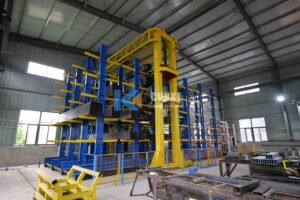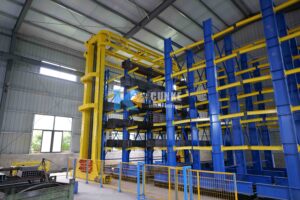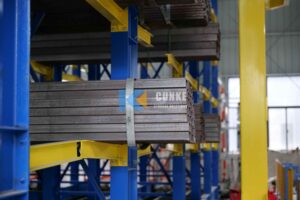Introduction: The Hidden Cost of Floor Stacking
Walk into any busy steel fabrication workshop and you’ll probably see the same scene: piles of long steel pipes stacked on the floor, aluminum profiles leaning against walls, workers shouting to find the right bundle. It feels like organized chaos.
The truth is, this setup isn’t just messy — it’s expensive. Floor stacking wastes floor space, slows down production, damages materials, and drives up labor costs. If your workshop ceiling is 10 meters high but your steel never leaves the floor, you’re literally burning money in unused air space.
The solution? A next-generation automated steel profile storage system. Let’s dive into why more and more manufacturers are making the switch — and why it might be the smartest upgrade for your warehouse this year.

Why Traditional Storage Fails in Modern Workshops
- Floor Stacking Chaos
Workers spend time moving bundles around just to reach one piece. Forklifts can’t maneuver safely, aisles get blocked, and accidents become a constant risk. - Wasted Vertical Space
Most warehouses are 8–12m high. Yet without specialized racking, only the bottom 1–2m is used. That’s like renting a three-story house and living only on the ground floor. - Material Damage
Soft materials like aluminum bend and deform when stacked directly on each other. Even steel can warp or get scratched during careless handling. - Labor Intensive & Slow
Finding the right size tube or profile often depends on memory, shouting, or luck. Each wasted minute compounds into hours of lost productivity every week.
In short: traditional racks and floor stacking were never designed for the scale and complexity of today’s manufacturing.
Introducing the Automated Steel Profile Storage System
This system combines high-strength cantilever racking, a gantry robot, and an intelligent control system to create a storage solution built specifically for long, heavy, and awkward materials.
Think of it as giving your warehouse a brain and muscles:
- The racks provide the structure.
- The gantry robot acts as the muscle — moving materials quickly and safely.
- The control system is the brain — knowing exactly where every profile is and how to retrieve it.
Now let’s break down what this means for you in practice.

- Space Optimization: Reach for the Ceiling
- Up to 9m high: The system can go as tall as your building allows (within design limits). That means the empty air above your workers becomes usable inventory space.
- Floor space savings: Customers typically free up half their floor area compared to floor stacking or low-level racks.
Imagine walking into your workshop tomorrow and suddenly having an extra 500 square meters of usable space without moving to a new building. That’s the power of vertical storage.
- Long Material? No Problem
- Handles materials up to 8m long with ease.
- For workshops that deal with standard 6m steel pipes or aluminum profiles, this is more than enough.
- For oversized materials, custom solutions are available.
Instead of cutting down materials to fit poor storage, you finally have storage designed around your actual production needs.
- Heavy Duty Capacity: 5 Tons per Position
Each rack position can safely carry up to 5,000 kg. That’s the equivalent of:
- A small car
- Or an entire bundle of steel tubes
This kind of load rating means you can consolidate storage instead of scattering heavy bundles across the floor. Fewer stacks = safer, cleaner, more efficient workshop.
- High-Speed Operation: Faster Than Any Worker
- Gantry travel speed: 18 m/min
- Lift speed: 9 m/min
- Rack movement speed: 9 m/min
Put simply, it’s like giving your warehouse its own “Flash” superhero. What takes workers minutes of shouting, lifting, and shuffling, the system completes in seconds — calmly, safely, and repeatably.
Result: higher throughput, shorter lead times, and happier workers.
- Smart Control System: The Warehouse Brain
The system doesn’t just store steel — it remembers every piece.
- WMS Integration: Connects with your Warehouse Management System for real-time inventory tracking.
- FIFO management: Ensures first-in, first-out material handling, reducing scrap and ensuring traceability.
- One operator control: Instead of three workers running around with forklifts, one trained operator manages everything from a console.
This means fewer mistakes, less training time, and total control of your inventory.
- Power Requirements: Balanced Efficiency
One common concern: “How much power will it consume?”
- A standard 10-row system requires ~30KW.
- That includes the gantry robot, racks, motors, and control system.
- It’s carefully balanced — not underpowered (which causes stalling and downtime) and not oversized (which would waste energy).
Think of it as running multiple household appliances at once — powerful enough to handle demand, but stable and efficient for long-term use.
- Installation Options: Designed for Any Workshop
The system runs on high-carbon steel rails, engineered for durability and heavy loads.
- Surface-mounted rail: Quick installation, cost-effective.
- Embedded rail: Flush with the floor, safer for forklift traffic, cleaner appearance.
Both options are engineered for stability — no wobble, no surprises. The choice depends on whether you prefer speed or seamless integration.
- Servo vs. Asynchronous Motors: Why Precision Wins
At the heart of automation are the motors. Here’s the difference:
- Servo Motor (recommended)
- High precision: stops exactly where it should, every time.
- Fast response: ideal for frequent start/stop cycles.
- Reliable under both light and heavy loads.
- Asynchronous Motor
- Lower cost, rugged design.
- Good for simple fans, pumps, conveyors.
- Not precise enough for automated gantry movements.
For automated racking where precision = productivity, servo motors are the clear winner. Yes, they cost more upfront — but they pay for themselves in fewer errors, faster throughput, and longer lifespan.
- Protecting Aluminum & Other Soft Materials
Steel is tough, but not every material in your shop is. Aluminum profiles are notorious for bending under their own weight.
That’s why the system can be paired with custom material frames :
- Keep materials straight and supported.
- Prevent damage during storage and handling.
- Allow the gantry to move entire frames safely, instead of individual bars.
This means less scrap, better quality, and fewer customer complaints.
- Who Benefits Most?
This system isn’t only for mega-factories. It’s already being used in:
- Steel service centers – to manage thousands of tons of profiles with accuracy.
- Fabrication shops – to keep workshops clean and production smooth.
- Aluminum extrusion plants – where material damage used to be a constant issue.
- Automotive & aerospace suppliers – where traceability and precision are critical.
If your workshop deals with long, heavy, or soft materials, this system could pay for itself faster than you think.

Real-World Benefits at a Glance
- Vertical floor space saved
- Store up to 8m long materials, 5 tons per position
- Pick materials faster with gantry automation
- Protect soft aluminum profiles with custom frames
- Integrate with WMS for smart, traceable inventory
- Safe & stable: no more risky forklift maneuvers
- Flexible installation: surface-mounted or embedded rail
- Servo motors = precision, speed, reliability
Conclusion: Don’t Blame Your Space, Blame Your System
When your warehouse feels too small, the answer isn’t always a bigger building. Sometimes the real issue is that your storage system belongs to another era.
An automated steel profile storage system turns unused air into usable space, chaos into order, and wasted time into productivity. It’s more than a rack — it’s a competitive advantage.
Ready to see how much space, time, and money you could save?
Contact our team today for a free consultation and tailored storage plan.
